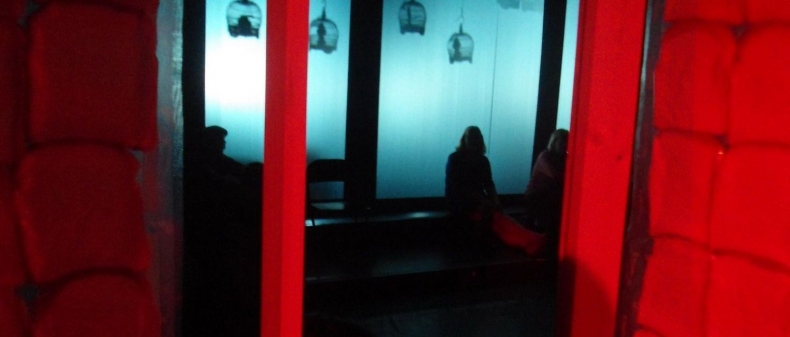
Food for thought: in the past, artists have explored the perils of our consumer-based society in many media, never, however quite like this. Inspired by Hansel and Gretel, the original fairy tale by the Grimm Brothers, The Hunger is a performance installation by Uncanny House, a collective of artists committed to interdisciplinary collaboration.
Directed by Margaret Krawecka, The Hunger is choreographed by Malgorzata Nowacka, with video projections by Ulysses Castellanos and sound design by Richard Windeyer. Originally conceived of in 2009, the project has seen several incarnations, continually developing to reach its present form. Working with key themes from the original fairytale, Uncanny House’s newest production makes a sharp critique of contemporary consumer culture.
For The Hunger, Uncanny House converted the blackbox Scotiabank Studio Theatre into a 500 square-foot interactive installation complete with the bare wood frame of small house, whose tiny rooms, nooks and crannies form a maze for the audience to walk through. Hanging in long plastic strips, the walls of the house are made up hundreds of vacuum packed slices of Wonder Bread. The audience winds their way through hanging wooden bird houses filled with the sounds of children’s voices and mini video screens, coupled with large-scale projections showing images of everything from runway models, to hands chopping, and dicing, raw meat.
The Hunger is about consumerism and escapism. “It’s about creating an atmosphere that has many layers,” says director Krawecka. “The story is about deception,” she says, referring to the original Grimm Brothers’ fairytale, in which Hansel and Gretel come upon a tantalizing gingerbread house covered in delicious treats, only to discover the owner is a wicked witch and it is all a trap to lure them in and capture them. “That moment of disillusionment that happens with deception and its kind of cruel” says Krawecka. “Appearances can be deceiving,” she adds, making reference to the mass food production, product advertising, and endless packaging of our consumer-based society.
Throughout the installation, dancers with long bird masks lead the audience through the maze-like space, carrying large white platters full of gingerbread cookies in small plastic baggies, enticing the audience to eat, to consume and to actively partake in the act of deception.
“It’s within reach, but at the same time, not” she says of the hanging bread sealed in plastic. “It’s about never being satisfied and always wanting more.”
After wandering through the makeshift bread-house, the audience sits on chairs scattered along the periphery of the space. With jerky bird-like movements, each coming alive in their own square of light, the dancers begin an interactive choreographed sequence.
Castellanos’ large video projections offer an eclectic backdrop of repeated images, amongst them, a whale’s jaws, a leopard hunting a helpless deer, and images from the fairytale itself.
At one point the dancers creep behind a large white screen, revealing only their shadows carrying small birdcages with gingerbread men trapped inside, a metaphor for the modern day consumer.
The atmosphere created by The Hunger is eerie, and unsettling. The installation’s impact is enhanced considerably by a dynamic lighting design by Snezana Pesic and set design by Andrea Mastrandrea.
A genuinely interdisciplinary creation, the audience is stimulated by so many media simultaneously it creates a disorienting experience. While the video projections, set, lighting, and sound seem to support each other thematically; at times the role of the bird-like dancers is more nebulous. Effective as guides animating the installation, the long choreographic sequences seem to pull the performance more into the realm of the theatrical, at times, competing with, rather than supporting the installation itself.
When asked whether or not Toronto is a supportive milieu for interdisciplinary artists, Krawecka answers yes, though she admits that it is still quite new and people are curious. Krawecka confesses that she struggles to find words to describe her work, while audiences and critics insist on labels, which, admittedly sometimes do not yet exist.
Imaginative, thought provoking, and conceptually strong, The Hunger is a truly interdisciplinary performance experience. With this production, Uncanny House boldly covers new ground, paving the way for other interdisciplinary artists in this burgeoning field.
The Hunger
May 24-27
Uncanny House
Scotiabank Studio Theatre
6 Noble St.
For tickets visit: www.thehunger.me
—–
For more, follow us on Twitter at @TorontoStandard and subscribe to our newsletter.














